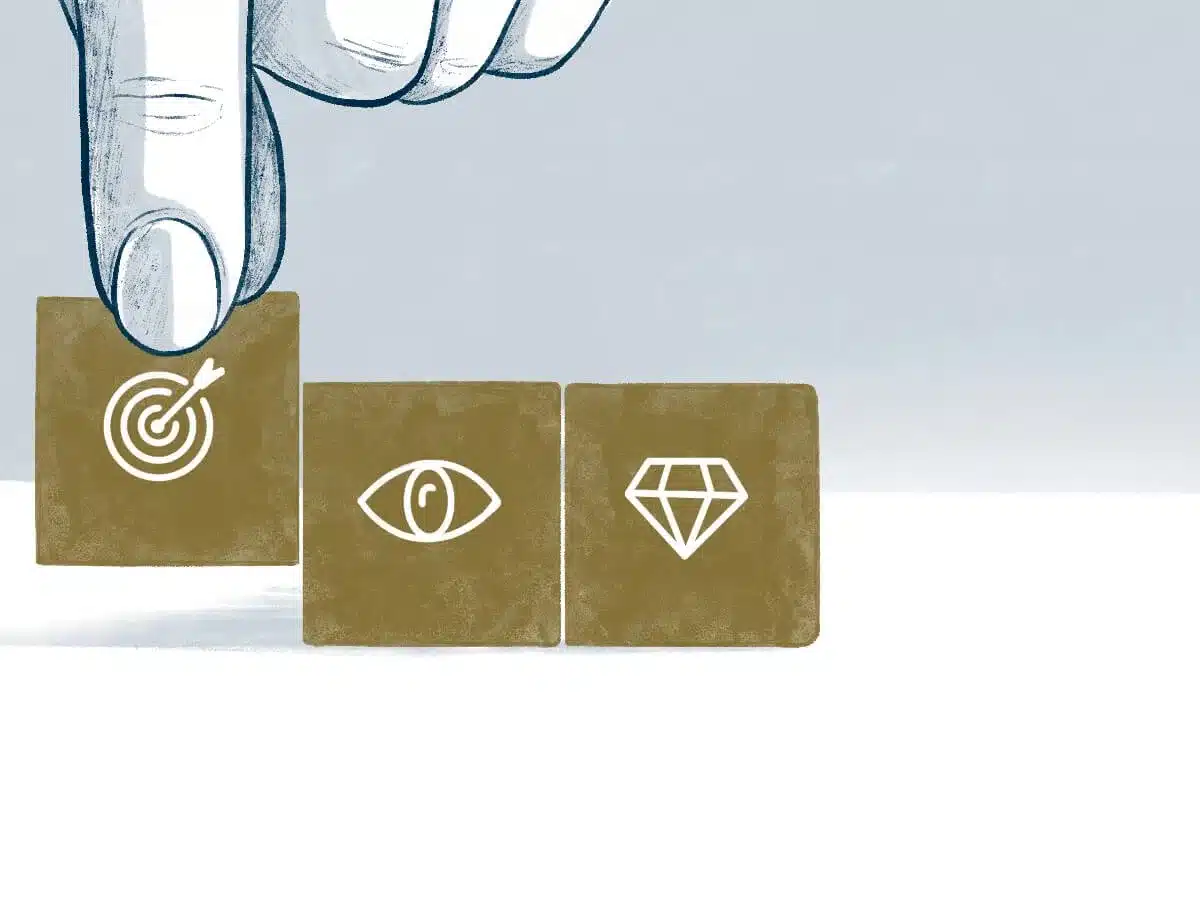Vision, mission and company culture often get mentioned in the same breath, however they are in fact three concepts that are quite different.
Vision and mission statements often get mixed up and interchanged unintentionally, so let’s clear up the differences between the two first.
A vision statement is the guiding light of your business, something that inspires and enrols. Something big, almost unattainable. It must have a higher purpose to it, not just to make more money. A great vision statement should be big and bold, it is where we aspire to be in the world and WHO we are and WHAT we want to be. A vision statement should be written in present tense, like an affirmation, to ‘live’ the statement now and give it more power. A bit like a self-fulfilling prophesy! It describes what we will feel, hear, think, say and do as if we had reached our vision now.

Vision statement examples
Here are some examples of famous companies’ vision statements across different industries:
“To make People Happy” – Disney (entertainment)
“To bring inspiration and innovation to every athlete in the world.” – Nike (retail)
“For every person to use their unique experiences and backgrounds, together – to spark solutions that create a better, healthier world.” – Johnson & Johnson (healthcare)
“To make the best products on earth, and to leave the world better than we found it.” – Apple (Technology)
“To be the world’s best quick service restaurant experience.” – McDonalds(Food & Beverage)
“To develop leaders who will one day make a global difference.” – Harvard University (Education)
“The enablers of global e-commerce” – UPS (Logistics)
“To enable economic growth through infrastructure and energy development, and to provide solutions that support communities and protect the planet.” – CAT (Construction)
“The web’s most convenient, secure and cost-effective payments solution.” – Paypal (Financial services)
“Improving people’s lives through meaningful innovation.” – Philips (Manufacturing)
“To prevent and alleviate human suffering in the face of emergencies by mobilizing the power of volunteers and the generosity of donors.” – Red Cross (Not for profit)
“To move the web forward and give web designers and developers the best tools and services in the world.” – Adobe (Advertising)
“We seek to reflect the best of Arabian hospitality in everything that we do.” – Etihad Airways (Airlines)
“Better health and active ageing for all Australians.” – Department of Health (Australian Government)
The difference between Vision & Mission
Where a vison statement is all about WHO we are and WHAT we want the organisation to be, a mission statement centres around HOW we are going to make our vision a reality. How do we conduct ourselves on a day-to-day basis, what do we do consistently in the here and now, every single day?
A mission statement is written in present tense to make it as meaningful and powerful as possible. It is a great reminder for current team members on how we conduct ourselves in our interactions with the outside world. On the other hand, it also serves as an efficient induction for any team member starting work with your business.
A mission statement expresses your purpose for existing; while a vision statement focuses on what you want your business to become in the future.
In other words, a good mission statement declares what you do currently, and a good vision statement is future oriented, detailing your aspirations and defining what you want your business to look like in the future.
Mission statement examples
Here is an example of a mission statement by one of my clients:
“We are a team of creative professionals that engage, inspire and empower through the delivery of high quality and innovative media, communications and events.”
And another example consisting of a few paragraphs:
“We are a team of committed individuals.
We achieve our vision through our common values.
We embrace Ownership, Accountability and Responsibility.
We empower and reward our people to make contributions to enhance customer fulfilment and the value of our business.”.
Culture statement (Rules of the game)
Lastly (but in no way less important than the vision and mission statements) is our culture statement. I often refer to the culture statement as ‘the rules of the game’. It is vital we are clear on these ‘rules’. They are our values. How we conduct ourselves as people.
Consider this; every organisation ends up with a culture eventually. The businesses who don’t articulate the culture they desire, inevitable end up with a rubbish culture they do not want. Moral of the story? May as well design the culture you do want to attract!
Far from ‘fluff’
Only some short years ago talk about designing a company culture would often raise eyebrows. Too fluffy, soft, and certainly not something we can afford to spend time and effort on. Let’s just get on with the order of the day and make some money!
These days it is much more appreciated that a great culture creates great teams and businesses where customers enjoy great experiences and therefore keep coming back, over and over again.
Your business’s ‘Points of Culture’ will be used to guide your team in their actions, priorities, and decisions. It provides accountability and framework for people to work within and therefore provides clarity and is unambiguous in what we expect from our people.
Culture examples
Following are some examples of client culture statements:
Empathy
We are driven by an outlook on life and business based on compassion and understanding.
Integrity
We value honesty and openness. We do what we say we will do.
We only ever make agreements we are willing and intend to keep.
We communicate any potential issues at the first opportunity and take responsibility
for our actions.
Collaboration
We work together in a trusting and respectful environment to achieve our common
goals. We pride ourselves on the creation of a unique working philosophy that values
synergy and respect. There is magic in the power of the group. Together we are
better.
Balance
We have a balanced approach to life, remembering that our spiritual, social,
physical, cultural and family aspects are just as important as our financial and
intellectual aspects. We take care of each other and check in when we feel
balance is being challenged.
Positivity
We believe in a can-do attitude, never giving up and that anything is possible.
Another example:
Commitment
We are committed to the vision and success of our business and understand that
in its success lies our success.
Ownership
We are 100% responsible for our actions and accountable for our results.
Excellence
We always strive to exceed guest and team expectations.
Innovation
We always look for ways to do things better.
Success
We focus our attention on the successful outcome of whatever we are doing.
Integrity
What we promise is what we deliver.
Gratitude
We are sincere and grateful and always display courtesy and appreciation to our guests and team.
Fun
We view life as a journey to be appreciated and help to create an atmosphere of fun and happiness so all of those around us enjoy it as well.
Crafting your points of culture
There is no hard and fast rule on how to create your culture statement. Often business owners will get their teams involved in discussing and crafting their points of culture. Creating these together typically leads to more ownership and accountability by the team.
Another approach is to list say three values that are imperative for you the owner, three values that are imperative for the customer, three values that are imperative for the team and three values that are imperative for the business.
I love helping clients gain focus and direction around these important concepts. Businesses that have clarity around their vision, mission and culture statements always have better direction and a sense of professionalism than businesses that don’t.
If you haven’t already done so it is time to take some action and get this process started. Feel free to contact me for an obligation free chat.
All the best,
Mark Vischschoonmaker
P. 0403 88 11 05





